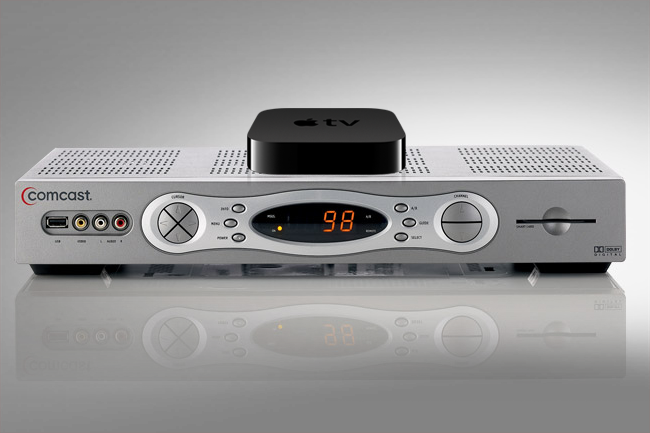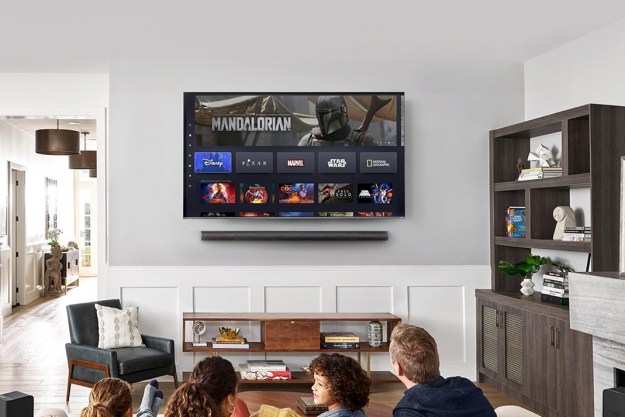
Ever since the Walter Isaacson’s 2011 biography revealed Steve Jobs believed he had “cracked” the problem of designing an integrated television system, Apple-watchers have been eagerly anticipating an “iTV.” Whether it’s in the form of set-top box the company had been peddling as a “hobby” until recently, or a full-fledged television, the idea is the same: Apple revolutionizing the living room the way iPod did for music players, the iPhone did done for smartphones, and the iPad did for tablets. And now the Wall Street Journal reports that Apple is in talks with cable giant Comcast about offering a streaming TV service that would offer live and on-demand content, leapfrogging other Internet video services. Many people are trying to connect the dots.
There’s little doubt television could do with some revolutionizing. Apple might be the company to do it, with elegant design and ease-of-use. But how would a partnership with Comcast solve anything? And wouldn’t putting Apple in Comcast’s fast lane serve a blow to net neutrality principles?
How would an Apple-Comcast service work?
Almost everything about an Apple-Comcast television service is guesswork at this point – and, unsurprisingly, neither Apple nor Comcast are talking about it. (Comcast declined to comment for this story; Apple did not respond to requests for comment.) According to the WSJ, the service would encompass both traditional cable offerings of live television and on-demand content, which are delivered digitally over Comcast’s cable television service, as well as access to digital video from the cloud.
Comcast’s image would benefit from associating with Apple’s famously high quality – and famously loyal customers.
This description matches the “broad parameters” of discussions Apple had with Time Warner Cable dating back to at least September of 2013, according to two sources with some knowledge of those talks. (Comcast is now moving to acquire Time Warner Cable for $45 billion.) Apple also reportedly had discussions with DirecTV.
This arrangement points to Apple developing a device that would function as a drop-in replacement for a Comcast set-top box. However, in addition to live television and video-on-demand, the cloud component means users would likely be able to access streaming video services, iTunes (to view, rent, or buy content) and iCloud (for a user’s own photos, videos, and music). Presumably all this would be presented via an integrated interface: live television, on-demand, cloud-based content (and, likely, DVR recordings), and personal media and apps all presented and managed seamlessly side-by-side.
How would this be better than an Apple TV?
Right now, Apple TV offers access to content from Disney (and subsidiaries like ABC and ESPN), PBS, HBO, Bloomberg, Sky News, and others, but access can be painful: users have to authenticate with different channel apps to prove they have an eligible cable or satellite subscription. Partnering with a cable provider could make the experience seamless: all eligible content would just work.
The rest of the magic might be behind the scenes. If Apple can get in Comcast’s fast lane network, Apple’s service would be head-and-shoulders above competitors like Amazon, Google Play, Sony, and Netflix. Apple’s service wouldn’t have to slog over the public Internet: it would just be faster and more reliable, particularly at peak hours. And, presumably, Apple’s service would be exempt from Comcast’s 250GB monthly bandwidth cap. All this would be important for 4K video streaming – that’s not really happening yet, but it’s on the horizon.

The benefits would likely extend to users in other ways as well. Miss an episode of your favorite show? A combined service could show you not only when the episode airs again (so you can set up a recording), but also provide direct access to it on iTunes or on-demand services (so you can watch it immediately). Thinking of renting a kids’ movie on iTunes for the wee ones? The service could let you know the same movie is available cheaper (or maybe for free) via on-demand. Apple could leverage Comcast’s X2 capabilities (or its own iCloud services) to offer access to your DVR recordings on iOS devices on the go.
This is all speculation, however – and, according to Comcast contacts not involved with discussions with Apple, would require Comcast to engineer and support new capabilities: it’s not stuff they have baked into their service now. But Apple has gone that route before: the iPhone’s visual voicemail was only possible in 2007 because Apple worked with AT&T to get capabilities installed and running.
Do Apple and Comcast need each other?
A partnership between Apple and Comcast could solve major problems for both companies – but that doesn’t mean it would be smooth sailing.
Right now there are no net neutrality rules in the United States.
There’s another elephant in the room. If Apple wants a nationwide rollout, Comcast is the only game in town. Comcast is already in 31 of the 50 largest metropolitan markets in the United States. If Comcast succeeds in acquiring Time Warner Cable, it will be in 43 of the top 50 markets. Comcast’s footprint is far larger than any other U.S. cable provider.
Does Comcast need Apple? Arguably, not very much. The company is making steady progress with its own platform, with its multi-tuner X1 systems and making DVR recordings available via the cloud. Comcast is expanding by buying Time Warner Cable, and it’s milking its position as gatekeeper to a large portion of the U.S. cable market to extract money from the likes of Netflix – sour grapes notwithstanding.

But at the same time, Comcast gets little love. For years, its customer satisfaction ratings were lower than even the Internal Revenue Service (last year Comcast improved to 63 out of 100 on the American Consumer Satisfaction Index). Things got so bad in 2010 that Comcast rebranded its services as Xfinity to put some distance between the company and Comcast’s bad name. There’s no question that Comcast’s image would benefit from associating with Apple’s famously high quality – and famously loyal customers.
Comcast has another worry: cord-cutters. Leading cable companies lost 1.7 million subscribers in 2013 as consumers (particularly young consumers) cancelled expensive cable television in favor of services like Netflix, Hulu, and Xbox Live. The trend isn’t enough to make Comcast quake yet, but launching a service with Apple might be a way to persuade some would-be cord-cutters to stick with Comcast – or even upgrade to get the new Apple service.
What about net neutrality?
Would a deal letting an Apple TV service leapfrog the public Internet be a violation of net neutrality? Maybe, maybe not.
Apple apparently wants to bypass the public Internet.
Comcast has promised to abide by net neutrality provisions through 2018 as a condition of its 2014 acquisition of NBCUniversal. However, if the company’s recent deals with Netflix (for preferred access) and Microsoft (so certain video program is exempt from data caps) don’t violate those principles, it’s unlikely a deal with Apple would be any different, since it seems to leave Comcast’s handling of the public Internet untouched.
Sticking points
Nobody thinks a deal between Comcast and Apple is imminent, and it may never happen. Money is sure to be a tough point – particularly if Comcast wants to offer an Apple service exclusively. (Apple might be willing to consider an exclusive window: they did it with AT&T and the iPhone.) Another issue is whether users are Apple customers or Comcast customers: who would they pay? To offer integration, Apple needs customers to use their Apple IDs, and is famously stingy about sharing that information with partners. Comcast, conversely, undoubtedly wants to retain control of customers, their payments, and their data. Let’s not forget cable boxes are a gold mine of demographic and viewer information for cable companies.
Any way you slice it, some unified convergence of live, on-demand, recorded, purchased, and streaming content is the next step for television – many would add gaming to that. While many products combine some of these elements – TiVo, Xbox One, PlayStation 4, cable and satellite services – none bring them all together, and precious few integrate the parts well. If Apple can pull that off with the same sort of panache that launched the iPhone and iPad, the company might just be able to re-invent TV – and put off the “Apple needs a new product right now!” naysayers for a month. Maybe two.
Editors' Recommendations
- How to figure out what size TV you should buy
- Hurry! This 75-inch 4K TV is discounted to $470 at Best Buy
- Best Sony TV deals: Save on best-in-class 4K TVs and 8K TVs
- Best QLED TV deals: Samsung, TCL, LG and Vizio
- Best projector deals: Replace your TV with a big screen from $80


